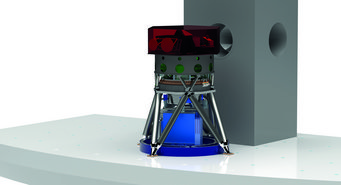ELT MICADO instrument successfully completes preliminary design phase
MICADO (Multi-Adaptive Optics Imaging Camera for Deep Observations), the first camera developed specifically for the E-ELT (European Extremely Large Telescope) still under construction, has passed the Preliminary Design Review (PDR). The Max Planck Institute for Astronomy (MPIA) is playing a key role in the development of the instrument.

A group of experts and the MICADO consortium, including MPIA, met at the ESO headquarters in Garching near Munich for a week of intensive review of the instrument's optics, mechanics, software and electronics to identify areas requiring further design work. The instrument will now go through another detailed design phase before the construction of the individual components can begin. MICADO will produce both images and spectra at wavelengths from 0.8 to 2.4 µm with extremely high positioning accuracy.
MICADO is supported by an adaptive optical system, MAORY, to improve the quality of observations and reach the diffraction limit of the 39-metre primary mirror. This means that the maximum achievable resolution or image sharpness of a telescope can be used. With adaptive optics, the considerable image blur caused by turbulence in the Earth's atmosphere can be corrected. In this respect, a 39-metre telescope is a huge leap in comparison to the current large telescopes of the 8-metre class.
The targets are diverse, ranging from exoplanets to galaxies in the early universe and the innermost environments of black holes. MICADO's spectroscopic capabilities will decipher the composition of these objects. The instrument will explore some of the most exciting questions in current astronomy: How are exoplanets formed? How do galactic black holes affect their host galaxies? How has the universe evolved over time?
When it becomes operational in the mid-2020s, the E-ELT of the European Southern Observatory (ESO), with its 39-meter main mirror, will be the largest optical telescope in the world. The combination of light collection power, angular resolution and astrometric accuracy of better than 50 microarcseconds with a spatial resolution of 10 milliarcseconds and a field of view of 53 arcseconds allows, for the first time, dense stellar distributions in the centre of galaxies and star clusters to be measured accurately using kinematics — with a sensitivity previously only provided by space telescopes.

The MPIA contributes significantly to the MICADO project in general, and to imaging astrometry in particular, which will be complementary to the Gaia satellite. For example, MPIA is developing the warm pre-optics, which guide starlight from the telescope into the cold camera optics with minimal loss of sensitivity and image sharpness. In addition, the MPIA provides the calibration unit for all standard scientific observation modes. During the PDR phase, a prototype in the MPIA laboratory successfully demonstrated that the extreme requirements for image field rotation and calibration can be met. The MICADO team at MPIA in the Department of Galaxies and Cosmology is led by Jörg-Uwe Pott (consortium-wide co-investigator and instrument scientist) as well as the local project manager Ralph Hofferbert and the systems engineer Friedrich Müller.
The MICADO consortium consists of:
Max-Planck-Institut für extraterrestrische Physik (MPE, Germany), Max-Planck-Institut für Astronomie (MPIA, Germany), Universitäts-Sternwarte München (USM, Germany), Institut für Astrophysik Göttingen (IAG, Germany), Nederlandse Onderzoekschool voor Astronomie (NOVA, The Netherlands), Osservatorio Astronomico di Padova-INAF (OAPD, Italy), CNRS/INSU (with contributiond by LESIA, GEPI and IPAG, France) and A*, a collaboration represented by the Universities of Vienna, Innsbruck and Linz (Austria).

